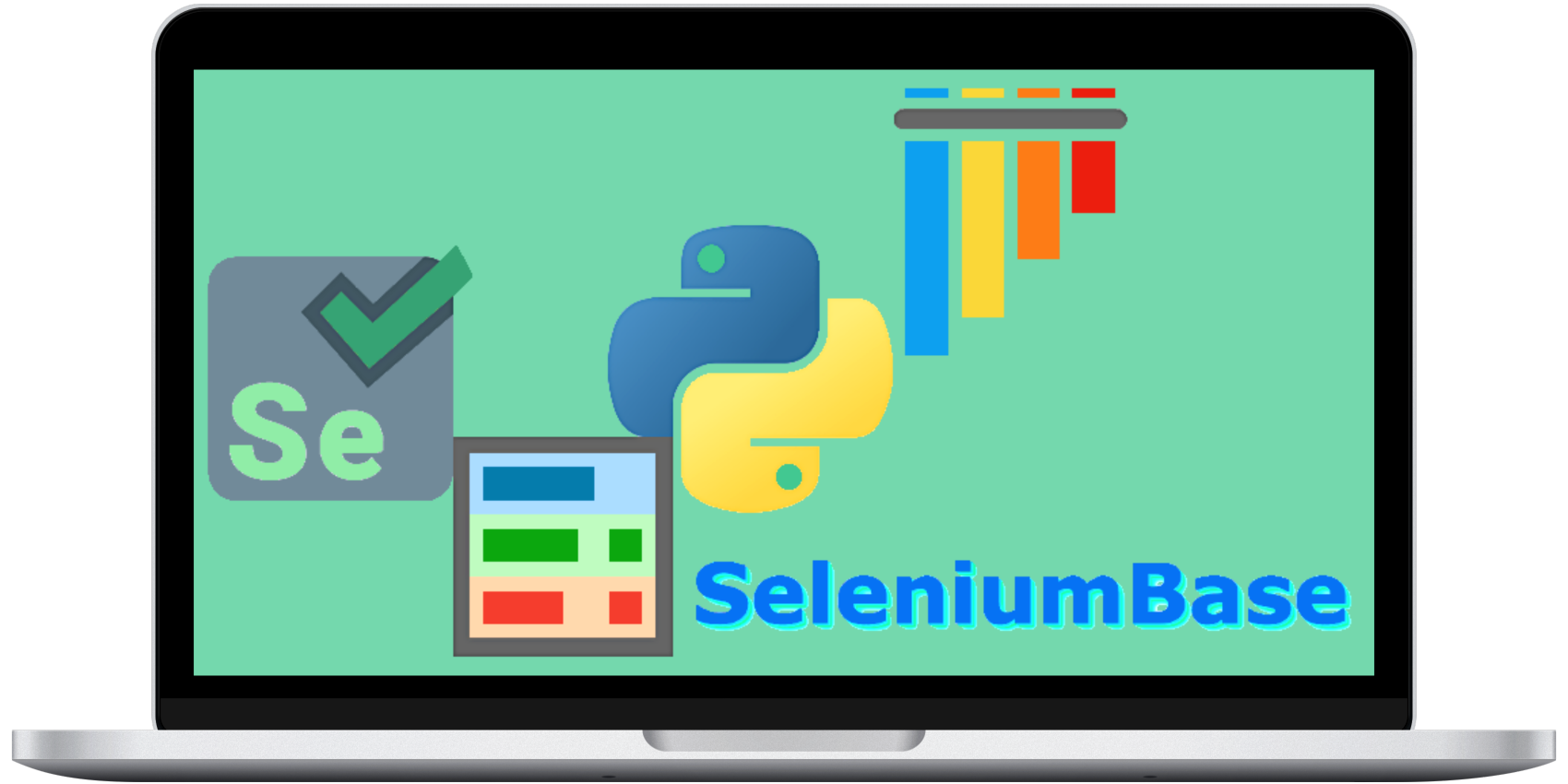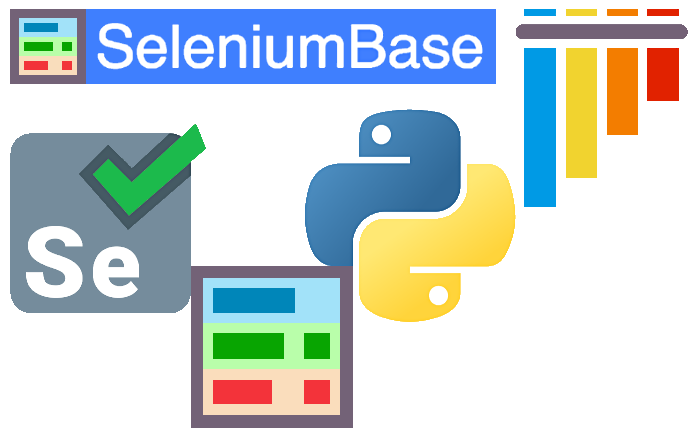26 KiB
Executable File
 The 17 syntax formats
The 17 syntax formats
(Watch this tutorial on YouTube)
SeleniumBase supports 17 different syntax formats (design patterns) for structuring tests. (The first 6 are the most common.)
 1.
1. BaseCase direct inheritance
This format is used by most of the examples in the SeleniumBase examples folder. It's a great starting point for anyone learning SeleniumBase, and it follows good object-oriented programming principles. In this format, BaseCase is imported at the top of a Python file, followed by a Python class inheriting BaseCase. Then, any test method defined in that class automatically gains access to SeleniumBase methods, including the setUp() and tearDown() methods that are automatically called to spin up and spin down web browsers at the beginning and end of test methods. Here's an example of that:
from seleniumbase import BaseCase
class MyTestClass(BaseCase):
def test_demo_site(self):
self.open("https://seleniumbase.io/demo_page")
self.type("#myTextInput", "This is Automated")
self.click("#myButton")
self.assert_element("tbody#tbodyId")
self.assert_text("Automation Practice", "h3")
self.click_link("SeleniumBase Demo Page")
self.assert_exact_text("Demo Page", "h1")
self.assert_no_js_errors()
(See examples/test_demo_site.py for the full test.)
 2.
2. BaseCase subclass inheritance
There are situations where you may want to customize the setUp and tearDown of your tests. Maybe you want to have all your tests login to a specific web site first, or maybe you want to have your tests report results through an API call depending on whether a test passed or failed. This can be done by creating a subclass of BaseCase and then carefully creating custom setUp() and tearDown() methods that don't overwrite the critical functionality of the default SeleniumBase setUp() and tearDown() methods. Afterwards, your test classes will inherit the subclass of BaseCase with the added functionality, rather than directly inheriting BaseCase itself. Here's an example of that:
from seleniumbase import BaseCase
class BaseTestCase(BaseCase):
def setUp(self):
super(BaseTestCase, self).setUp()
# <<< Run custom setUp() code for tests AFTER the super().setUp() >>>
def tearDown(self):
self.save_teardown_screenshot()
if self.has_exception():
# <<< Run custom code if the test failed. >>>
pass
else:
# <<< Run custom code if the test passed. >>>
pass
# (Wrap unreliable tearDown() code in a try/except block.)
# <<< Run custom tearDown() code BEFORE the super().tearDown() >>>
super(BaseTestCase, self).tearDown()
def login(self):
# <<< Placeholder. Add your code here. >>>
# Reduce duplicate code in tests by having reusable methods like this.
# If the UI changes, the fix can be applied in one place.
pass
def example_method(self):
# <<< Placeholder. Add your code here. >>>
pass
class MyTests(BaseTestCase):
def test_example(self):
self.login()
self.example_method()
self.type("input", "Name")
self.click("form button")
...
(See examples/boilerplates/base_test_case.py for more info.)
 3. The
3. The sb pytest fixture (no class)
The pytest framework comes with a unique system called fixtures, which replaces import statements at the top of Python files by importing libraries directly into test definitions. More than just being an import, a pytest fixture can also automatically call predefined setUp() and tearDown() methods at the beginning and end of test methods. To work, sb is added as an argument to each test method definition that needs SeleniumBase functionality. This means you no longer need import statements in your Python files to use SeleniumBase. If using other pytest fixtures in your tests, you may need to use the SeleniumBase fixture (instead of BaseCase class inheritance) for compatibility reasons. Here's an example of the sb fixture in a test that does not use Python classes:
def test_sb_fixture_with_no_class(sb):
sb.open("https://google.com/ncr")
sb.type('input[title="Search"]', 'SeleniumBase\n')
sb.click('a[href*="github.com/seleniumbase/SeleniumBase"]')
sb.click('a[title="seleniumbase"]')
(See the top of examples/test_sb_fixture.py for the test.)
 4. The
4. The sb pytest fixture (in class)
The sb pytest fixture can also be used inside of a class. There is a slight change to the syntax because that means test methods must also include self in their argument definitions when test methods are defined. (The self argument represents the class object, and is used in every test method that lives inside of a class.) Once again, no import statements are needed in your Python files for this to work. Here's an example of using the sb fixture in a test method that lives inside of a Python class:
class Test_SB_Fixture:
def test_sb_fixture_inside_class(self, sb):
sb.open("https://google.com/ncr")
sb.type('input[title="Search"]', 'SeleniumBase\n')
sb.click('a[href*="github.com/seleniumbase/SeleniumBase"]')
sb.click('a[title="examples"]')
(See the bottom of examples/test_sb_fixture.py for the test.)
 5. The classic Page Object Model with
5. The classic Page Object Model with BaseCase inheritance
With SeleniumBase, you can use Page Objects to break out code from tests, but remember, the self variable (from test methods that inherit BaseCase) contains the driver and all other framework-specific variable definitions. Therefore, that self must be passed as an arg into any outside class method in order to call SeleniumBase methods from there. In the example below, the self variable from the test method is passed into the sb arg of the Page Object class method because the self arg of the Page Object class method is already being used for its own class. Every Python class method definition must include the self as the first arg.
from seleniumbase import BaseCase
class LoginPage:
def login_to_swag_labs(self, sb, username):
sb.open("https://www.saucedemo.com")
sb.type("#user-name", username)
sb.type("#password", "secret_sauce")
sb.click('input[type="submit"]')
class MyTests(BaseCase):
def test_swag_labs_login(self):
LoginPage().login_to_swag_labs(self, "standard_user")
self.assert_element("#inventory_container")
self.assert_element('div:contains("Sauce Labs Backpack")')
(See examples/boilerplates/samples/swag_labs_test.py for the full test.)
 6. The classic Page Object Model with the
6. The classic Page Object Model with the sb pytest fixture
This is similar to the classic Page Object Model with BaseCase inheritance, except that this time we pass the sb pytest fixture from the test into the sb arg of the page object class method, (instead of passing self). Now that you're using sb as a pytest fixture, you no longer need to import BaseCase anywhere in your code. See the example below:
class LoginPage:
def login_to_swag_labs(self, sb, username):
sb.open("https://www.saucedemo.com")
sb.type("#user-name", username)
sb.type("#password", "secret_sauce")
sb.click('input[type="submit"]')
class MyTests:
def test_swag_labs_login(self, sb):
LoginPage().login_to_swag_labs(sb, "standard_user")
sb.assert_element("#inventory_container")
sb.assert_element('div:contains("Sauce Labs Backpack")')
(See examples/boilerplates/samples/sb_swag_test.py for the full test.)
 7. Using the
7. Using the request fixture to get the sb fixture (no class)
The pytest request fixture can be used to retrieve other pytest fixtures from within tests, such as the sb fixture. This allows you to have more control over when fixtures get initialized because the fixture no longer needs to be loaded at the very beginning of test methods. This is done by calling request.getfixturevalue('sb') from the test. Here's an example of using the pytest request fixture to load the sb fixture in a test method that does not use Python classes:
def test_request_sb_fixture(request):
sb = request.getfixturevalue('sb')
sb.open("https://seleniumbase.io/demo_page")
sb.assert_text("SeleniumBase", "#myForm h2")
sb.assert_element("input#myTextInput")
sb.type("#myTextarea", "This is me")
sb.click("#myButton")
sb.tearDown()
(See the top of examples/test_request_sb_fixture.py for the test.)
 8. Using the
8. Using the request fixture to get the sb fixture (in class)
The pytest request fixture can also be used to get the sb fixture from inside a Python class. Here's an example of that:
class Test_Request_Fixture:
def test_request_sb_fixture_in_class(self, request):
sb = request.getfixturevalue('sb')
sb.open("https://seleniumbase.io/demo_page")
sb.assert_element("input#myTextInput")
sb.type("#myTextarea", "Automated")
sb.assert_text("This Text is Green", "#pText")
sb.click("#myButton")
sb.assert_text("This Text is Purple", "#pText")
sb.tearDown()
(See the bottom of examples/test_request_sb_fixture.py for the test.)
 9. SeleniumBase in Chinese
9. SeleniumBase in Chinese
This format is similar to the English version with BaseCase inheritance, but there's a different import statement, and method names have been translated into Chinese. Here's an example of that:
from seleniumbase.translate.chinese import 硒测试用例
class 我的测试类(硒测试用例):
def test_例子1(self):
self.开启网址("https://xkcd.in/comic?lg=cn&id=353")
self.断言标题("Python - XKCD中文站")
self.断言元素("#content div.comic-body")
self.断言文本("上漫画")
self.单击("div.nextLink")
self.断言文本("母亲的功绩", "#content h1")
self.单击链接文本("下一篇")
self.断言文本("敲打", "#content h1")
self.断言文本("有时,最有趣的事也会显得无聊")
self.回去()
self.单击链接文本("兰德尔·门罗")
self.断言文本("兰德尔·门罗", "#firstHeading")
self.输入文本("#searchInput", "程式设计")
self.单击("#searchButton")
self.断言文本("程序设计", "#firstHeading")
(See examples/translations/chinese_test_1.py for the Chinese test.)
 10. SeleniumBase in Dutch
10. SeleniumBase in Dutch
This format is similar to the English version with BaseCase inheritance, but there's a different import statement, and method names have been translated into Dutch. Here's an example of that:
from seleniumbase.translate.dutch import Testgeval
class MijnTestklasse(Testgeval):
def test_voorbeeld_1(self):
self.openen("https://nl.wikipedia.org/wiki/Hoofdpagina")
self.controleren_element('a[title*="hoofdpagina gaan"]')
self.controleren_tekst("Welkom op Wikipedia", "td.hp-welkom")
self.typ("#searchInput", "Stroopwafel")
self.klik("#searchButton")
self.controleren_tekst("Stroopwafel", "#firstHeading")
self.controleren_element('img[alt="Stroopwafels"]')
self.typ("#searchInput", "Rijksmuseum Amsterdam")
self.klik("#searchButton")
self.controleren_tekst("Rijksmuseum", "#firstHeading")
self.controleren_element('img[alt="Het Rijksmuseum"]')
self.terug()
self.controleren_ware("Stroopwafel" in self.huidige_url_ophalen())
self.vooruit()
self.controleren_ware("Rijksmuseum" in self.huidige_url_ophalen())
(See examples/translations/dutch_test_1.py for the Dutch test.)
 11. SeleniumBase in French
11. SeleniumBase in French
This format is similar to the English version with BaseCase inheritance, but there's a different import statement, and method names have been translated into French. Here's an example of that:
from seleniumbase.translate.french import CasDeBase
class MaClasseDeTest(CasDeBase):
def test_exemple_1(self):
self.ouvrir("https://fr.wikipedia.org/wiki/")
self.vérifier_texte("Wikipédia")
self.vérifier_élément('[alt="Wikipédia"]')
self.taper("#searchInput", "Crème brûlée")
self.cliquer("#searchButton")
self.vérifier_texte("Crème brûlée", "#firstHeading")
self.vérifier_élément('img[alt*="Crème brûlée"]')
self.taper("#searchInput", "Jardin des Tuileries")
self.cliquer("#searchButton")
self.vérifier_texte("Jardin des Tuileries", "#firstHeading")
self.vérifier_élément('img[alt*="Jardin des Tuileries"]')
self.retour()
self.vérifier_vrai("brûlée" in self.obtenir_url_actuelle())
self.en_avant()
self.vérifier_vrai("Jardin" in self.obtenir_url_actuelle())
(See examples/translations/french_test_1.py for the French test.)
 12. SeleniumBase in Italian
12. SeleniumBase in Italian
This format is similar to the English version with BaseCase inheritance, but there's a different import statement, and method names have been translated into Italian. Here's an example of that:
from seleniumbase.translate.italian import CasoDiProva
class MiaClasseDiTest(CasoDiProva):
def test_esempio_1(self):
self.apri("https://it.wikipedia.org/wiki/")
self.verificare_testo("Wikipedia")
self.verificare_elemento('[title="Lingua italiana"]')
self.digitare("#searchInput", "Pizza")
self.fare_clic("#searchButton")
self.verificare_testo("Pizza", "#firstHeading")
self.verificare_elemento('img[alt*="pizza"]')
self.digitare("#searchInput", "Colosseo")
self.fare_clic("#searchButton")
self.verificare_testo("Colosseo", "#firstHeading")
self.verificare_elemento('img[alt*="Colosse"]')
self.indietro()
self.verificare_vero("Pizza" in self.ottenere_url_corrente())
self.avanti()
self.verificare_vero("Colosseo" in self.ottenere_url_corrente())
(See examples/translations/italian_test_1.py for the Italian test.)
 13. SeleniumBase in Japanese
13. SeleniumBase in Japanese
This format is similar to the English version with BaseCase inheritance, but there's a different import statement, and method names have been translated into Japanese. Here's an example of that:
from seleniumbase.translate.japanese import セレニウムテストケース
class 私のテストクラス(セレニウムテストケース):
def test_例1(self):
self.を開く("https://ja.wikipedia.org/wiki/")
self.テキストを確認する("ウィキペディア")
self.要素を確認する('[title="メインページに移動する"]')
self.入力("#searchInput", "アニメ")
self.クリックして("#searchButton")
self.テキストを確認する("アニメ", "#firstHeading")
self.入力("#searchInput", "寿司")
self.クリックして("#searchButton")
self.テキストを確認する("寿司", "#firstHeading")
self.要素を確認する('img[alt="握り寿司"]')
self.入力("#searchInput", "レゴランド・ジャパン")
self.クリックして("#searchButton")
self.要素を確認する('img[alt="Legoland japan.jpg"]')
self.リンクテキストを確認する("名古屋城")
self.リンクテキストをクリックします("テーマパーク")
self.テキストを確認する("テーマパーク", "#firstHeading")
(See examples/translations/japanese_test_1.py for the Japanese test.)
 14. SeleniumBase in Korean
14. SeleniumBase in Korean
This format is similar to the English version with BaseCase inheritance, but there's a different import statement, and method names have been translated into Korean. Here's an example of that:
from seleniumbase.translate.korean import 셀레늄_테스트_케이스
class 테스트_클래스(셀레늄_테스트_케이스):
def test_실시예_1(self):
self.열기("https://ko.wikipedia.org/wiki/")
self.텍스트_확인("위키백과")
self.요소_확인('[title="위키백과:소개"]')
self.입력("#searchInput", "김치")
self.클릭("#searchButton")
self.텍스트_확인("김치", "#firstHeading")
self.요소_확인('img[alt="Various kimchi.jpg"]')
self.링크_텍스트_확인("한국 요리")
self.입력("#searchInput", "비빔밥")
self.클릭("#searchButton")
self.텍스트_확인("비빔밥", "#firstHeading")
self.요소_확인('img[alt="Dolsot-bibimbap.jpg"]')
self.링크_텍스트를_클릭합니다("돌솥비빔밥")
self.텍스트_확인("돌솥비빔밥", "#firstHeading")
(See examples/translations/korean_test_1.py for the Korean test.)
 15. SeleniumBase in Portuguese
15. SeleniumBase in Portuguese
This format is similar to the English version with BaseCase inheritance, but there's a different import statement, and method names have been translated into Portuguese. Here's an example of that:
from seleniumbase.translate.portuguese import CasoDeTeste
class MinhaClasseDeTeste(CasoDeTeste):
def test_exemplo_1(self):
self.abrir("https://pt.wikipedia.org/wiki/")
self.verificar_texto("Wikipédia")
self.verificar_elemento('[title="Língua portuguesa"]')
self.digitar("#searchInput", "João Pessoa")
self.clique("#searchButton")
self.verificar_texto("João Pessoa", "#firstHeading")
self.verificar_elemento('img[alt*="João Pessoa"]')
self.digitar("#searchInput", "Florianópolis")
self.clique("#searchButton")
self.verificar_texto("Florianópolis", "h1#firstHeading")
self.verificar_elemento('img[alt*="Avenida Beira Mar"]')
self.voltar()
self.verificar_verdade("João" in self.obter_url_atual())
self.digitar("#searchInput", "Teatro Amazonas")
self.clique("#searchButton")
self.verificar_texto("Teatro Amazonas", "#firstHeading")
self.verificar_texto_do_link("Festival Amazonas de Ópera")
(See examples/translations/portuguese_test_1.py for the Portuguese test.)
 16. SeleniumBase in Russian
16. SeleniumBase in Russian
This format is similar to the English version with BaseCase inheritance, but there's a different import statement, and method names have been translated into Russian. Here's an example of that:
from seleniumbase.translate.russian import ТестНаСелен
class МойТестовыйКласс(ТестНаСелен):
def test_пример_1(self):
self.открыть("https://ru.wikipedia.org/wiki/")
self.подтвердить_элемент('[title="Русский язык"]')
self.подтвердить_текст("Википедия", "h2.main-wikimedia-header")
self.введите("#searchInput", "МГУ")
self.нажмите("#searchButton")
self.подтвердить_текст("университет", "#firstHeading")
self.подтвердить_элемент('img[alt*="Главное здание МГУ"]')
self.введите("#searchInput", "приключения Шурика")
self.нажмите("#searchButton")
self.подтвердить_текст("Операция «Ы» и другие приключения Шурика")
self.подтвердить_элемент('img[alt="Постер фильма"]')
self.назад()
self.подтвердить_правду("университет" in self.получить_текущий_URL())
self.вперед()
self.подтвердить_правду("Шурика" in self.получить_текущий_URL())
(See examples/translations/russian_test_1.py for the Russian test.)
 17. SeleniumBase in Spanish
17. SeleniumBase in Spanish
This format is similar to the English version with BaseCase inheritance, but there's a different import statement, and method names have been translated into Spanish. Here's an example of that:
from seleniumbase.translate.spanish import CasoDePrueba
class MiClaseDePrueba(CasoDePrueba):
def test_ejemplo_1(self):
self.abrir("https://es.wikipedia.org/wiki/")
self.verificar_texto("Wikipedia")
self.verificar_elemento('[title*="la página principal"]')
self.escriba("#searchInput", "Parc d'Atraccions Tibidabo")
self.haga_clic("#searchButton")
self.verificar_texto("Tibidabo", "#firstHeading")
self.verificar_elemento('img[alt*="Tibidabo"]')
self.escriba("#searchInput", "Palma de Mallorca")
self.haga_clic("#searchButton")
self.verificar_texto("Palma de Mallorca", "#firstHeading")
self.verificar_elemento('img[alt*="Palma"]')
self.volver()
self.verificar_verdad("Tibidabo" in self.obtener_url_actual())
self.adelante()
self.verificar_verdad("Mallorca" in self.obtener_url_actual())
(See examples/translations/spanish_test_1.py for the Spanish test.)


